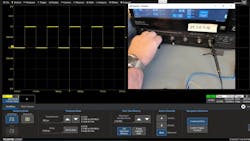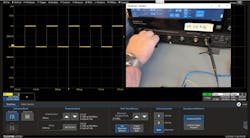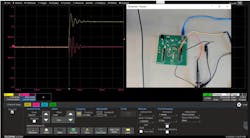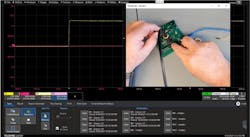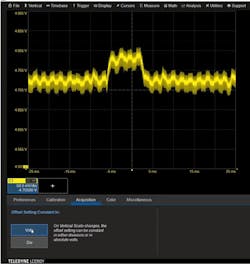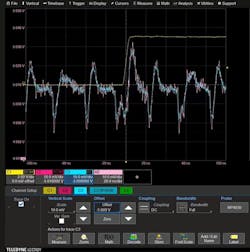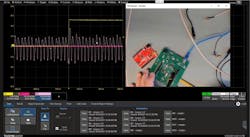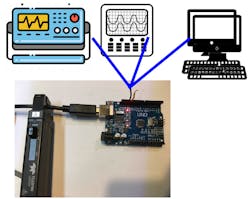Six Tips for Power Integrity Debug with an Oscilloscope
Members can download this article in PDF format.
What you’ll learn:
- Remember fundamentals and practice situational awareness in taking measurements.
- It’s not only using the right probe, but it’s also using the probe right.
- Eliminating measurement artifacts is tricky, but not impossible.
An oscilloscope is an essential instrument for making power integrity (PI) measurements, but to apply it effectively, you’ll need situational awareness. Be aware of the oscilloscope features, the signal features, and potential measurement artifacts that could impede your view of the real signal. Key scope features include the bandwidth, sample rate, time base, vertical scale, input impedance, channel bandwidth, and probe bandwidth.
Demonstrations of measurements on sample microcontroller boards illustrate six tips that you can apply to your own PI debug tasks. In addition to an oscilloscope, you will need high-performance probes and the ability to choose the optimum versions—including 10x passive, power-rail, near-field, current, and differential probes—for your application.
Tip 1: Get the most out of your 10x passive probe
The 10x passive probe is the workhorse probe for most oscilloscope measurements. The first thing you want to do is apply color bands on your 10x passive probes that match the color of the corresponding oscilloscope trace to keep track of what you’re measuring. If using multiple probes, it’s easy to get confused about which probe is measuring which location, and color coding can save time in the long run.
If you’re probing a circuit under test and expect to see a square wave but see something else, don’t assume the problem necessarily lies in your circuit. Check your 10x passive probe’s compensation. Fundamentally, your 10x passive probe includes a 9-MΩ resistor with a 10-pF shunt capacitor. The probe and oscilloscope together present a high-pass and a low-pass filter to the signal of interest.
Compensation ensures the poles of the two filters align for optimum measurement performance. To perform compensation, connect your probe’s tip to the oscilloscope’s COMP signal and use the adjustment near the probe cable’s connection to the oscilloscope to obtain a flat response, as shown in Figure 1 (a recent webinar1 provides video of it and other demonstrations described in this article).
Many anomalies may be measurement artifacts that don’t represent the performance of the circuit you’re investigating. Figure 2 shows a microcontroller board digital output that transitions from 0 to 1 (yellow) and a quiet signal that should remain low (red). The ringing on the transitioning signal and the crosstalk induced on the quiet signal result from the loop inductance of the long, floppy wires (see the Fig. 2 inset) used to make the 10x passive probe signal and ground connections.
Using low-inductance spring tips on your probes to eliminate the wires also removes the ringing and crosstalk they caused (Fig. 3). And when designing your board, it’s a good design-for-test practice to provide sufficient test points and grounds to accommodate your probe tips.
Tip 2: Use dc coupling for power-rail measurements
If you’re looking for small variations in noise on a 5-V power rail, you may be inclined to use ac coupling. It lets you zoom in and out on the signal without having to reposition the trace on the screen every time you change the vertical scale. However, when you do that, you lose information about slow drift or other variations, because everything below about 10 Hz is filtered out.
Fortunately, you can adopt a trick to conveniently use dc coupling without constant repositioning. The feature varies among different oscilloscope manufacturers, but on many Teledyne LeCroy oscilloscopes, you use the onscreen menus to navigate from Utilities to Preferences to Acquisition and are presented with two options: Offset Setting Constant in: Volts or Div (Fig. 4). If you choose Volts and center your signal, your signal will remain centered as you expand the vertical scale to zoom in to look for clock-edge noise or other disturbances on the rail.
Tip 3: Use a rail probe to measure switching noise
When looking at the power rails, consider using a rail probe, such as the Teledyne LeCroy RP4030. The RP4030 is a 4-GHz, dc-coupled active probe designed to measure the low impedances of the power rails but with the benefits of a high signal-to-noise ratio (SNR) and high bandwidth.
Like the 10x passive probe, the rail probe includes two paths. First is a passive ac-coupled path for high frequencies that acts like a high-pass filter with a pole frequency of about 10 to 100 kHz. The second path consists of two inverting amplifiers with a 16-bit digital-to-analog converter (DAC) that enables precision offset control. This path together with the oscilloscope’s input impedance acts as a low-pass filter, and again, it’s necessary to align the poles of the high- and low-pass filters to obtain a flat response.
Note that the rail probe presents a very high impedance at low frequencies to minimize dc loading on the rail. For the high frequencies, though, the rail probe matches the 50-Ω impedance of the oscilloscope input to minimize reflections. Figure 5 shows a noise signal measured with the rail probe (blue trace) overlaid with the same measurement made using a 10x passive probe (red trace). The rail probe provides a cleaner, higher-fidelity view of the clock-edge noise on the board’s power rail.
Tip 4: Use a near-field probe to locate EMI problems
When looking for potential EMI problems during the pre-compliance test, opt for a near-field probe. Note that the near-field probe is essentially a low-impedance loop, so take care to connect it to a 50-Ω oscilloscope input—not a 1-MΩ input—to prevent reflections and ringing. In addition, when probing a microcontroller board, a useful technique is to trigger the oscilloscope on a switching I/O signal, so that the observed waveform will be synchronized with the microcontroller’s clock.
Figure 6 shows superimposed bottom-of-the-board near-field probing results for two microcontroller boards. These boards have the exact same circuitry and are running the exact same code, but one features a superior layout with a copper-pour return plane, as described in a recently released textbook.2
As the figure shows, near-field emissions are barely measurable for the board with superior layout (red trace). However, they’re substantial for the other board (pink trace), demonstrating that using good return-path control dramatically reduces near-field emissions.
Tip 5: Use a current probe to find ground loops
A high-sensitivity current probe can help measure common ground-loop currents found in USB cables and other external connections. These currents can arise from the different ground potentials of multiple instruments connected to the microcontroller demo board, for example. They can fluctuate quickly if the ground potential differences result from switching within the demo board or the devices connected to it.
This demonstration takes advantage of the Teledyne LeCroy CP031A clamp-on current probe. It incorporates a Hall-effect sensor and a pick-up coil to enable current measurements from dc to 100 MHz and from milliamps to 30 A.
As shown in Figure 7, a USB cable connected to a PC powers the microcontroller board without carrying data. The PC in turn connects to earth ground by way of a three-prong plug.
With this setup, no common current flows in the USB cable. However, connecting a ground pin on the microcontroller board to ground on another external device plugged into the wall can result in common currents reaching 75 mA. Only 5 mA is required to fail an FCC part 15 class B test. The current probe is useful in viewing common currents that can occur if you have multiple connected external devices each making their own connection to ground.
Tip 6: Use a differential probe to check a microcontroller’s current draw
To measure the actual current that the microcontroller draws in real-time, use a differential probe. First, insert a sense resistor—for example, 0.5 Ω—in the series path of the power rail, and then measure the voltage across it. You could use two single-ended probes, one to measure the voltage to ground on each side of the resistor. However, that would involve subtracting one large number from another to get the voltage across the resistor, which can introduce inaccuracies.
Instead, use the differential probe, which is designed to measure small voltage differences with a large common dc offset. You can use the differential probe and sense resistor to measure inrush as well as steady-state current.
To look at inrush current, set your oscilloscope’s trigger to normal mode, which is used to look at transient signals. Figure 8 shows more than 2 V across the sense resistor during the inrush period, indicating an inrush current of more than 4 A as the demo board’s decoupling capacitors charge up. Within about 200 ms of power being applied, the current nears its steady-state value.
To investigate steady-state current draw in detail, trigger the oscilloscope on a transitioning signal to look for anomalies, if any, that might be synchronous with the microcontroller clock.
Summary
In conclusion, keep in mind that it’s easy to do a measurement, but hard to do so without artifacts. Practice situational awareness. Make sure you use the right probe for the right application. Use the 10x passive probe with low-inductance ground connections to the extent possible. Then, use a rail probe for measurements requiring high bandwidth and SNR, use a near-field probe for pre-compliance EMC testing, turn to a current probe to measure common currents, and use a differential probe with a series resistor to measure inrush and steady-state currents.
For purposes of this article, measurements were taken using an 8-GHz, 4-channel Teledyne LeCroy WavePro HD oscilloscope. Some relevant specs for the instrument include 12 bits of vertical resolution, a 20-GS/s sample rate, and a 5-GS acquisition memory.
References
1. Bogatin, Eric, 5 Tips for Power Integrity Debug Webinar, Teledyne LeCroy
2. Bogatin, Eric, Bogatin's Practical Guide to Prototype Breadboard and PCB Design, Artech House, 2021.
About the Author
Stephen Murphy
Applications Engineer, Teledyne LeCroy
Stephen Murphy has been involved in electronic test equipment and in-circuit test (ICT) systems for nearly 40 years, the last 25 years at Teledyne LeCroy. He is widely known for his expertise in testing switch-mode power supplies and power semiconductor devices, and for applying oscilloscopes to a variety of power-electronics application areas. He holds a B.S. in electrical engineering from Northeastern University and an A.S. in electrical engineering from Wentworth Institute.
